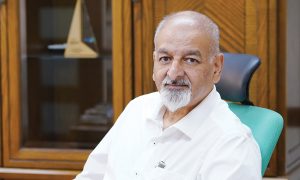The process of visioning may seem both daunting and mysterious. Indeed, it is in no way a straightforward method and there are always rocky rapids to navigate. An understanding of the make-up of this journey will create better results for this process to be a success.
Visioning – the process of coming up with breakthrough ideas – is often assumed to be an isolated and instantaneous affair. What commonly happens is that a new concept is developed over a sustained period of time. Looking back, such a period will be riddled with moments of serendipity, moments where lucky connections, unexpected insights and breakthroughs made the difference. These breakthroughs are rarely the product of one mind; they almost always are the result of cross-pollination of ideas, and approaches from a different field being applied to the field the creative person is working on.
Successful visioning repeatedly has core characteristics and creative leadership means trying to create as many of these conditions as possible. However, when this cannot be done, it means knowing what to look out for when they do occur and then making space to benefit from them. So creative leadership needs to know what to look out for. Here are seven core characteristics isolated:
1. It is slow and fast, wide and focused
A process of visioning includes bursts of energy as well as ‘slow bake’ periods. Bursts of energy are alert, focused efforts to make a real breakthroughs, to push through barriers and resolve a paradox. Moments of relaxation are needed to allow the unconstrained, subconscious mind to work, make connections with past experience, analogies and weak signals picked up in an initial sensing phase. Creative leadership means recognizing when a period of incubation is needed. The breakthrough – the seeing of the perfect idea – often happens through deceleration. By seeing the picture in slow motion, the creative leader sees ‘the key in the grass’. It requires patience and discipline when pressure starts mounting to take the necessary time to slow down.
Changing gears rather than quitting. A skill all creative leadership should know about.
Visioning is both wide and focused, because creative leadership has to ensure a continuous switch between divergent and convergent thinking. Divergent thinking involves generating multiple answers to a set problem. Keywords include broadening the solution space, looking for alternatives, going for quantity of ideas, postponing judgment, dialogue, letting go, introducing chaos, following intuition. Convergent thinking involves aiming for a single, correct solution to a problem.
2. Combinatory play
To create is to combine existing bits of insight or ideas into new material and new interpretations of the world, to connect the seemingly dissociated. Einstein called this Combinatorial Play. Steve Jobs said, “creativity is just connecting things”. Wind surfing is a very clear example: combining the surfboard and the sailboat yielded a new sports equipment in the 1960s. The same happened again with kite surfing, connecting kite flying and wind surfing.
Here it helps if creative leadership itself has a lifetime of experience that provides a rich source of analogies. Creative leadership often includes having a truly explorative mind: The role models have a broad orientation and are interested in collecting information on a wide range of unrelated topics, from history to physics, to name just a few. There is often no direct application, but these insights serve as analogies to draw from when visioning in the future just like Gutenberg in 1450 combined insights from the wine-pressing and his profession of goldsmith to come up with a printing system that led to the first assembly line-style mass production of books.
3. Pursuing the slow hunch
A slow hunch is the feeling an innovative idea or vision is to be found in a certain direction without been able to pinpoint it yet. By pursuing this hunch, over time the idea crystallizes. It becomes clearer and clearer. Some speak about a process of ‘uncovering’ – the idea already existed, but it needed to be revealed. Even though Charles Darwin himself claimed the theory of natural selection occurred to him on September 28, 1838, while reading Thomas Malthus’s essay on population; Darwin’s own notebooks however reveal that the theory was forming clearly in his mind more than a year before: it wasn’t a flash of insight, but what Steven Johnson calls a ”slow hunch”.
4. Detecting through intensive observation
Visioning is hard work. One can detect the unseen by studying a topic very intensely over a longer period, until the point where one can ‘see through their subject’. If one studies a subject so closely, without time being an issue, one will develop different and new ways of seeing.
sometimes using a grass exercise as a metaphor for this way of observing: by using a substantial part of a day for the observation of just one square meter of grass, one will experience completely different ways of watching, seeing, interpretation and ideating. An example here is the electrical engineer George de Mestral who in 1948 returned from a nature hike with his dog to find himself and the dog covered with burrs, little annoying prickly seeds.
Thanks to De Mestral’s inventor mindset he spent the whole day analyzing the clingy seeds through a microscope. Eventually even under a microscope. What he saw through the lens amazed him: burrs are plant seeds covered in small hooks. These hooks attach to the fur of animals, spreading the plant as far as the carrier animal travels. De Mestral realized that these hooks could form the basis of a new type of fastener. By creating pieces of cloth with burr-like hooks woven into them, two pieces could be joined. De Mestral experimented with various cloths and hook-making processes for three years, usually working with small batches of custom-woven cotton. The velvet-like appearance of this original cloth, lent the product its name, which DeMestral derived from the French words for velvet “velour” and hook – “crochet.” The result was Velcro. In 1951, he applied for a patent.
5. Taking a different angle
Seeing what most people do not see. Creative leadership works with ‘twisted eyes’ and therefore sees unexpected perspectives, typically by making the non-obvious connections. Team members immediately wonder why they have not seen it from this angle before because it seems to be so simple. The challenge for creative leadership lies in knowing how much stretch is optimal. An example here was how a small nation changed its outlook on itself. Most people saw Mauritius as a small island in the Indian Ocean, a tiny nation state. By purposefully changing that perspective, Mauritius started seeing itself as the largest ocean state in the world and this gave energy and ideas for a different approach to positioning itself in the international community.
6. Producing for waste
Creative leadership can mean keeping on producing as a process to constantly develop a vision. It is a labor-intensive process of one failing experiment after another, resulting in a lot of waste along the way. The Master painters provide a good example for this way of visioning: many produced many paintings varying with light, composition, colors, etc., before discovering exactly the right way to create a breakthrough. 7. Creating the right brief
A brief is an articulation of the challenge at hand. “Right” means neither too general, which fails to motivate, nor too specific, which closes off directions for creative solutions. A right brief often poses some contradictory or paradoxical element, making it a ‘have your cake and eat it too’ kind of challenge, such as lower costs and improve quality. Even though creative leadership puts a lot of effort in getting the initial brief right it will change.
As people develop a better understanding and intuition of the task at hand also the perspective on a brief changes. This leads to re-briefs which may be essentially different from the original one. Just like the GE-engineer in charge of the development of MRI-scans, Doug Dietz, changed the brief from “How can we improve the machine” to “How can we improve the experience of young patients with the machine?” This led to improvements in the children’s experience by turning the machine into a pirate ship or space craft that saved money on anesthesiologists and, of course in human terms, by reducing the fear and terror the already sick children had to go through.
7-Predicting the future by making it happen
Visioning is not forecasting. Forecasting is predicting what will happen, whereas visioning is ultimately about making it happen. Visioning is one step in the bigger process of concepting, which together with the stages of realization make up innovation. Creative leadership means having such a strong conviction that an idea will work, that its realization is driven with relentless commitment. This compulsive determination is required to push through all the barriers and convince the critics.
Visioning brings the backgrounds, attitudes, emotions and dynamics of the creative team and of each individual team members involved to the equation. As a result, the creation process is never replicable: every effort leads to a unique outcome. And the choice of team members matters enormously.
Success cannot be ensured. Any attempt of creative leadership to realize a big vision or a break-through concept is risky- the probability of failure or disappointment is very significant. The rule of thumb of Venture Capital firms is that in their portfolio may be one out ten will become the huge success, while the large majority just survives or flounders and has to be closed down. So the idea is to strive for a truly great outcome, do everything possible to make it happen, but realize that the probability of a huge success is small and therefore adapt constantly to new insights and opportunities.
Menu








